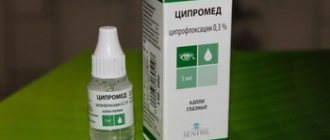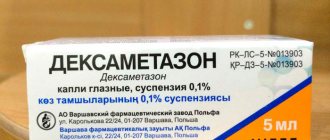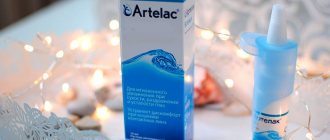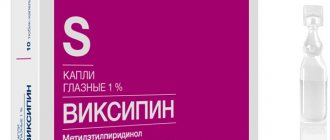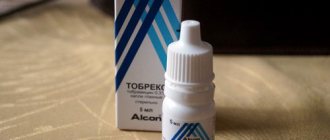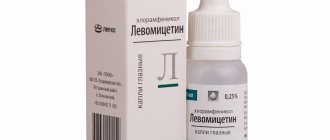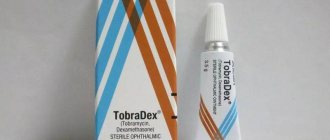Pharmacodynamics and pharmacokinetics
It is worth remembering that in fact Albucid and Sulfacyl sodium are the same medicinal product with a similar composition and the same properties. Sulfacyl sodium eye drops are Albucid, marketed under a different trade name.
Albucid and Sulfacyl sodium are local antibacterial drugs from the sulfonamide sulfacetamide as an active ingredient . These medications are usually used in ophthalmology as eye drops, and in some cases in otorhinolaryngology as nasal drops (the instructions for using sulfacetamide in such cases are different).
The spectrum of antimicrobial effectiveness of sulfacetamide is quite wide, and its main effect is characterized as bacteriostatic, achieved through competitive inhibition of dihydropteroate synthetase and antagonism to PABA, resulting in disruption of the production of tetrahydrofolic acid, which is important in the synthesis of bacterial pyrimidines and purines .
The bacteriostatic activity of sulfacetamide is directed against pathogenic gram-negative and gram-positive cocci, as well as bacterial strains Actinomyces spp., pathogenic strains of Escherichia coli, Shigella spp, Chlamydia spp., Vibrio cholerae, Toxoplasma gondii, Clostidium perfringens, Actinomyces israelii, Bacillus anthracis, Yersinia pestis, Coryne bacterium diphtheriae.
When used topically in ophthalmology, sulfacetamide penetrates the ocular tissues and exerts its specific antibacterial effect on them. It is characterized primarily by its local influence, although part of the therapeutic agent, passing through the inflamed conjunctiva, penetrates the systemic bloodstream.
30 minutes after the instillation process, the Cmax of sulfonamides in the cornea is approximately 3 mg/ml, in the iris approximately 0.1 mg/ml and in the humor of the anterior chamber approximately 0.5 mg/ml. A certain amount of sulfacetamide (less than 0.5 mg/ml) remains in the eye tissues for 3-4 hours. If drops get on the damaged part epithelium , sulfonamide penetration increases.
Interaction with other drugs
When applied topically, the drops are incompatible with medications containing silver ions. Combined use with local anesthetics (Lidocaine, Novocaine) reduces the bacteriostatic effect of Albucid. Salicylates and PAS may increase the toxicity of sulfonamides. When used with indirect anticoagulants, the activity of the latter increases slightly.
Indications for use
In ophthalmology, the use of drops is indicated for:
- conjunctivitis (including bacterial infections in conjunctivitis in children);
- purulent ulcerative lesions of the cornea;
- various blepharitis ;
- foreign bodies getting into the eyes;
- chlamydial and gonorrheal pathologies of the visual organs in adults;
- blenorrhea in newborns (as prevention and therapy).
In otorhinolaryngology, some doctors allow the use of drops for the treatment of rhinitis of bacterial etiology (including childhood).
Release form
Eye drops 20%. 5 or 10 ml in PE bottles, sealed with caps. Each bottle is placed in a cardboard pack.
In pharmacies you can find Sulfacyl Sodium eye drops 20%, 30%, as well as powder in packaging.
The medication Sulfacyl sodium (another name is Albucid or sodium sulfacetamide) is available as sulfacetamide eye drops in dropper bottles, in most cases with a volume of 5 or 10 ml.
1) In a dropper tube there is a solution of 20% and 30%, 1.5 ml each. The box contains 2 tubes. Convenient to use in case of eye damage. The liquid is transparent, stings the eyes very much, it is better not to apply it to lenses
2) A solution of albucid 20% or 30% with methylcellulose 10% is available in bottles of 5 ml or 10 ml. The packaging of the drug contains only one bottle inside
3) 30% solution of albucid with metabisulfite, available in bottles of 5 ml and 10 ml.
Albucid eye drops, instructions for use (Method and dosage)
Sulfacyl sodium in ophthalmology
In ophthalmology, the instructions for use of Albucid suggest its local use 4-6 times per day, with instillation of drops (1-2) into the left and right conjunctival sac (inner canthus). The duration of treatment varies depending on the disease diagnosed and its severity.
For newborn children, in order to prevent blenorrhea , instillation of 2 drops into the left and right conjunctival sac immediately after their birth is indicated, as well as 2 drops after 120 minutes after the first procedure.
Albucid for runny nose in children and adults
Some doctors, in turn, practice using Albucid for a runny nose ( rhinitis ) complicated by a bacterial infection. Is it possible to drip Albucid into the nose of children and adults, and even more so whether it is possible to drip it into the nose of infants, the question is controversial and still open.
For example, Dr. Komarovsky calls this practice “an imitation of therapeutic activity” and believes that before dripping Albucid into a child’s nose, you should familiarize yourself with its effect and advisability of use, especially since at this time there are other nasal drops for children intended just for such cases. Thus, the reviews of Albucid in the nose of infants left by Komarovsky, if they do not have an extremely negative connotation, are certainly not recommendatory. On the other hand, there are many testimonies from parents who were strongly advised by pediatricians to drip Albucid into the baby’s nose, while verbally giving detailed instructions on its use, which indicates considerable experience in this particular use of this drug.
According to the recommendations of such pediatricians, Sulfacyl sodium should be dripped into the nose of children in a dosage of 100 mg/1 ml (10%) or 200 mg/1 ml (20%) 2-3 drops (in each nasal passage) 3-4 times every 24 hours , after rinsing the child’s nasal passages and/or after using vasoconstrictor drops. The average duration of such treatment, in the presence of positive dynamics, is 5-7 days. After the instillation process, the child may experience negative passing sensations in the form of burning and itching.
Overdose
Albucid is an eye drop that is recommended for local treatment in small doses. Therefore, if you follow all the rules for its use, an overdose can be excluded.
If Albucid accidentally enters the body, the patient must rinse the stomach and take a certain amount of activated carbon. This enterosorbent will absorb all toxic substances and remove them. Thus, the negative impact of the eye medication on the human body will be reduced.
You should not use drops more often than recommended by your doctor. If for any reason a large amount of medication gets into the eye, it will cause burning, watery eyes, and swelling. In this case, you need to rinse your eye and wait until the unpleasant symptoms pass. Next time you should reduce the amount of the substance and the frequency of instillation.
Analogues of eye drops Albucid
Level 4 ATC code matches:
Sulfacyl Sodium
Analogues of Albucid are represented by the drug Sulfacil sodium powder for the throat, as well as local medicinal products with a similar antibacterial effect:
- Tobrex
- Gentamicin
- Azidrop
- Colbiocin
- Nettatsin
- Fucithalmic
- Levomycetin
- Erythromycin
- Nettavisk
- Tetracycline
Albucid or Tobrex – which is better?
Both Sulfacyl sodium and Tobrex in the form of eye drops are drugs with antibacterial activity with almost identical indications and contraindications for their use and similar side effects (it is believed that when using sulfacetamide, a burning sensation is felt more often and more acutely).
Tobrex is a modern therapeutic agent with a broader spectrum of antimicrobial action and greater efficiency, however, its cost is several times higher than the cost of sodium sulfacyl. Both of these drugs, in most cases, do a good job of their task, and therefore the choice between them depends on the severity of the disease, the doctor’s preferences and the patient’s ability to pay.
Compound
The active ingredient of the drug is sodium sulfacetamide monohydrate. Additional ingredients: sodium thiosulfate, purified water, hydrochloric acid.
| Eye drops | 1 ml |
| active substance: | |
| sodium sulfacetamide monohydrate (sodium sulfacetamide), calculated as 100% substance | 200 mg |
| excipients: sodium thiosulfate - 1 mg; hydrochloric acid solution 1 M - to pH 8; water for injection - up to 1 ml |
One ml of solution contains 200 or 300 mg of sulfacetamide (20% and 30%, respectively). Additional substances: thiosulfate, hydrochloric acid solution, liquid for injection.
The working active component of Albucid is sulfacetamide (sodium sulfacyl). This is an antimicrobial agent from the sulfonamide group, which has a wide spectrum of antibacterial activity.
The medicine is produced in the form of a 20% solution, which is enclosed in special dropper bottles of 5 and 10 ml. A separate bottle is placed in a cardboard package, which contains complete recommendations for the use of the medicine. Albucid drops are a clear, colorless or slightly yellowish liquid. They must not contain foreign impurities or inclusions.
The international nonproprietary name (INN) of the active ingredient in Albucid is sulfacetamide (trade name Sulfacyl sodium) at a dosage of 100 mg, 200 mg or 300 mg per 1 milliliter (10%, 20% or 30%).
Additionally, Albucid eye drops most often include: sodium thiosulfate, water for injection and sodium hydroxide.
Reviews about Albucid
Due to many years of productive experience in using this drug, reviews of Sulfacyl sodium eye drops are very numerous and, as usual, extremely positive. When this medication is used for its main indications, as a rule, there is a rapid decrease in the negative symptoms of the disease and rapid relief from the bacterial infection, without serious side effects.
When Albucid is administered nasally to children, reviews of its effectiveness are not so clear. Some doctors in their practice often prescribe it for runny noses in children with green nasal discharge, considering this a reason to suspect a bacterial infection, others are categorically against such use of these eye drops and talk about their complete uselessness in this case. To be fair, it is worth noting many positive reviews from parents who treated their children in this way and are planning to practice similar therapy in the future.
Side effects
When using eye drops, side effects may occur, as with any other drug. This usually manifests itself in the form of skin hyperemia (redness), itching, and swelling of the eyes.
People who are sensitive to components of this drug may experience:
- Burning of the mucous membranes of the eyes.
- Blurred vision.
- Itching.
- It hurts in the eyes.
- Tearing.
These symptoms only last for a short time. If any unusual reactions occur as a result of using Albucid, you should immediately report them to your doctor. The specialist will assess the situation and decide on the advisability of continuing therapy or prescribe another drug.
Albucid price, where to buy
Due to the domestic production of Sulfacyl sodium, the price of Albucid eye drops is quite low and approximately the same for all manufacturers and in all regions.
The price of Albucid eye drops in St. Petersburg (St. Petersburg) is commensurate with the price of eye drops in Moscow and other cities of Russia, where their cost varies between 30-80 rubles.
The price in Ukraine for Sulfacyl sodium also does not depend on the region, and therefore you can buy Albucid in Kyiv for the same amount as it costs, for example, in Kharkov - 15-20 hryvnia.
- Online pharmacies in RussiaRussia
- Online pharmacies in KazakhstanKazakhstan
ZdravCity
- Sodium sulfacyl (Albucid) eye drops 20% dropper bottle 10 ml JSC "LEKKO"
33 rub. order
show more
special instructions
Persons with hypersensitivity to thiazide diuretics and furosemide, sulfonylurea derivatives, as well as carbonic anhydrase inhibitors may exhibit increased sensitivity to sulfacetamide.
For inflammatory eye diseases, during which Albucid is used, it is recommended to temporarily stop wearing contact lenses and use other methods of vision correction.
The drug is stored in a cool, dark place, away from children. The shelf life indicated on the packaging is 2 years. An opened dropper bottle is used within a month.
Trade names
Sulfacetamide
Sulfacetamidum (
Sulfacetamidi)
N-[(4-Aminophenyl)sulfonyl]acetamide
| Name | The value of the Vyshkowski Index ® |
| Sulfacyl sodium | 0.0164 |
| Sulfacyl sodium solution 20% | 0.0035 |
| Sulfacyl sodium | 0.0015 |
| Sulfacyl sodium-DIA | 0.0007 |
| Sulfacyl sodium | 0.0005 |
| Sodium sulfacetamide | 0.0005 |
| Sulfacyl sodium-SOLOpharm | 0.0005 |
| Sulfacyl sodium solution 20% in tube droppers | 0.0003 |
| Sulfacetamide sodium | 0.0001 |
| Sulfacyl sodium-Vial | 0.0001 |
| Sulfacyl sodium solution 10%-MEZ | 0 |
| Sulfacyl sodium bufus | 0 |
| Sulfacyl sodium (Albucid) | 0 |
Newborns
Medicine for newborns, as a rule, is instilled immediately after birth to prevent the development of blenorrhea.
In addition, Sodium Sulfacyl is often used in the nose of infants. The doctor prescribes this remedy for a prolonged runny nose, especially when it comes to a bacterial infection. It should be borne in mind that if the drug gets into the nose, it can cause a burning sensation, which is why the child begins to be capricious.
Synonyms of nosological groups
| Category ICD-10 | Synonyms of diseases according to ICD-10 |
| A54.3 Gonococcal eye infection | Blennorea |
| Blennorea in newborns | |
| Gonoblenorrhea | |
| Gonococcal conjunctivitis in adults | |
| Gonorrheal eye diseases | |
| Acute gonococcal conjunctivitis | |
| A74.0 Chlamydial conjunctivitis | Ocular chlamydial infection |
| Infectious conjunctivitis and keratoconjunctivitis caused by Chlamydia trachomatis | |
| Chlamydial eye infection | |
| Chlamydial eye diseases | |
| Chlamydial blepharoconjunctivitis | |
| Chlamydia of the organs of vision | |
| H01.0 Blepharitis | Blepharitis |
| Inflammation of the eyelids | |
| Inflammatory diseases of the eyelids | |
| Demodectic blepharitis | |
| Superficial bacterial eye infection | |
| Superficial eye infection | |
| Squamous blepharitis | |
| H10 Conjunctivitis | Bacterial conjunctivitis |
| Infectious-inflammatory conjunctivitis | |
| Superficial eye infection | |
| Red eye syndrome | |
| Chronic non-infectious conjunctivitis | |
| H16.0 Corneal ulcer | Allergic marginal corneal ulcer |
| Allergic corneal ulcer | |
| Bacterial corneal ulcer | |
| Purulent corneal ulcer | |
| Purulent corneal ulcers | |
| Corneal ulceration | |
| Ulcerations of the superficial layers of the cornea | |
| Keratitis with corneal ulcerations | |
| Keratomalacia | |
| Corneal ulcer | |
| Corneal marginal ulcer | |
| Recurrent corneal erosions | |
| Recurrent corneal ulcers | |
| Septic corneal ulcer | |
| Traumatic corneal erosion | |
| Trophic ulcers of the cornea | |
| Epithelial punctate keratitis | |
| Corneal erosion | |
| Regional ulcer | |
| Corneal ulcer | |
| Ulcerative keratitis | |
| P39.8 Other specified infection specific to the perinatal period | Blennorea in newborns |
| Nosocomial infections in newborns | |
| Neonatal herpes |
Medicinal properties
“Sulfacyl sodium” (or “Albucid”) exhibits moderate bacteriostatic properties against gram-positive and gram-negative bacteria. These bacteria include: pneumococci, chlamydia, streptococci, actinomycetes, gonococci, E. coli.
The aqueous solution is slightly alkaline, so it can be safely used as eye drops. Contact with the conjunctival sac of the eye will not cause any harm. Albucid for the eyes predominantly acts locally on the affected conjunctiva, but part of the active substance is absorbed into the body. The mechanism of action of “Sodium Sulfacyl” is determined by counteracting para-aminobenzoic acid and binding of dihydropteroate synthetase.
The average price is from 50 to 100 rubles.
Pharmacological group of the substance Sulfacetamide
| Category ICD-10 | Synonyms of diseases according to ICD-10 |
| A54.3 Gonococcal eye infection | Blennorea |
| Blennorea in newborns | |
| Gonoblenorrhea | |
| Gonococcal conjunctivitis in adults | |
| Gonorrheal eye diseases | |
| Acute gonococcal conjunctivitis | |
| A74.0 Chlamydial conjunctivitis | Ocular chlamydial infection |
| Infectious conjunctivitis and keratoconjunctivitis caused by Chlamydia trachomatis | |
| Chlamydial eye infection | |
| Chlamydial eye diseases | |
| Chlamydial blepharoconjunctivitis | |
| Chlamydia of the organs of vision | |
| H01.0 Blepharitis | Blepharitis |
| Inflammation of the eyelids | |
| Inflammatory diseases of the eyelids | |
| Demodectic blepharitis | |
| Superficial bacterial eye infection | |
| Superficial eye infection | |
| Squamous blepharitis | |
| H10 Conjunctivitis | Bacterial conjunctivitis |
| Infectious-inflammatory conjunctivitis | |
| Superficial eye infection | |
| Red eye syndrome | |
| Chronic non-infectious conjunctivitis | |
| H16.0 Corneal ulcer | Allergic marginal corneal ulcer |
| Allergic corneal ulcer | |
| Bacterial corneal ulcer | |
| Purulent corneal ulcer | |
| Purulent corneal ulcers | |
| Corneal ulceration | |
| Ulcerations of the superficial layers of the cornea | |
| Keratitis with corneal ulcerations | |
| Keratomalacia | |
| Corneal ulcer | |
| Corneal marginal ulcer | |
| Recurrent corneal erosions | |
| Recurrent corneal ulcers | |
| Septic corneal ulcer | |
| Traumatic corneal erosion | |
| Trophic ulcers of the cornea | |
| Epithelial punctate keratitis | |
| Corneal erosion | |
| Regional ulcer | |
| Corneal ulcer | |
| Ulcerative keratitis | |
| P39.8 Other specified infection specific to the perinatal period | Blennorea in newborns |
| Nosocomial infections in newborns | |
| Neonatal herpes |


